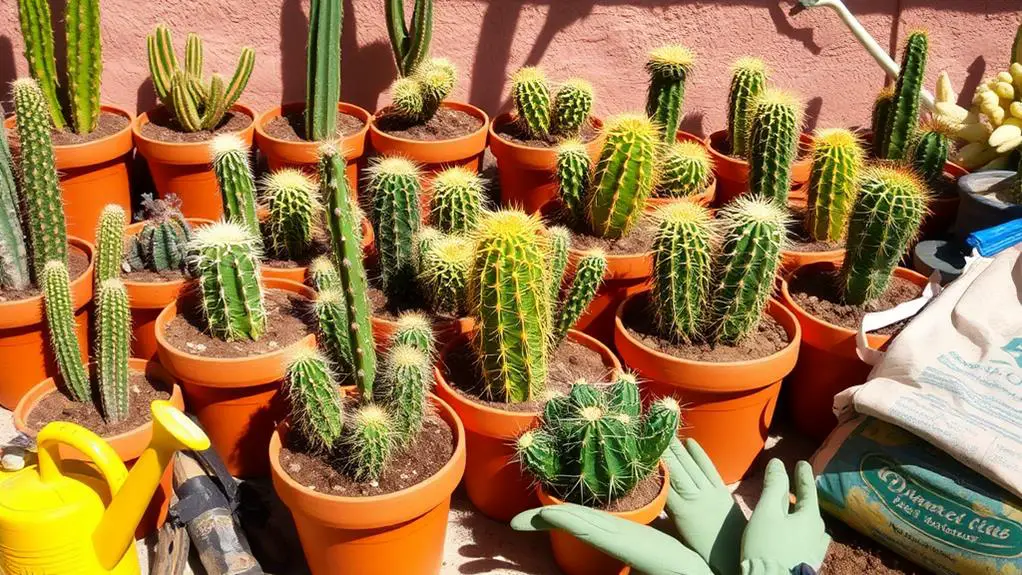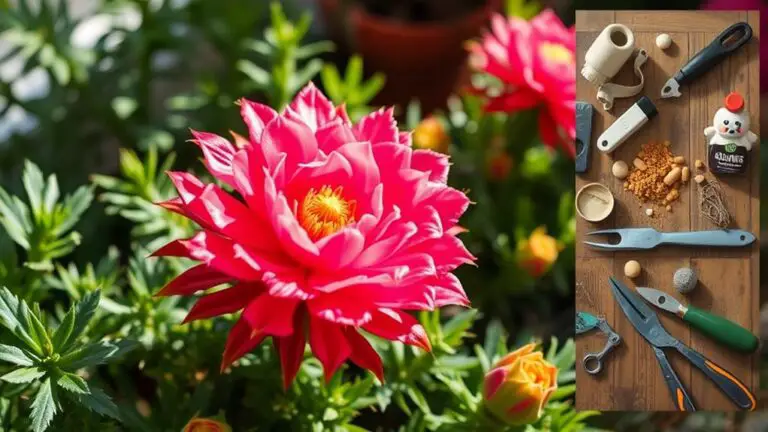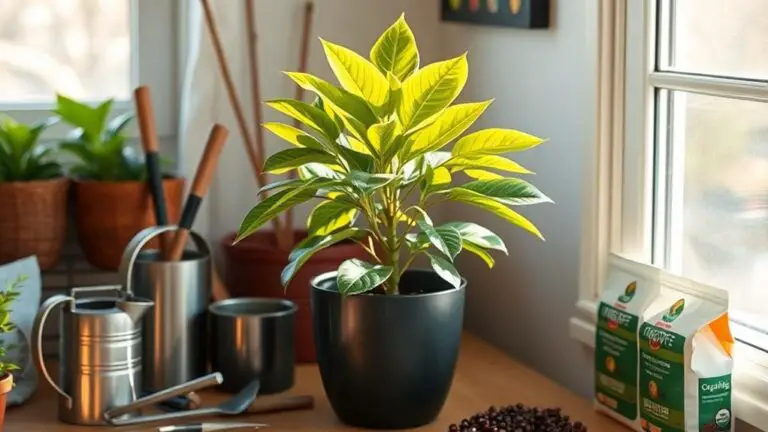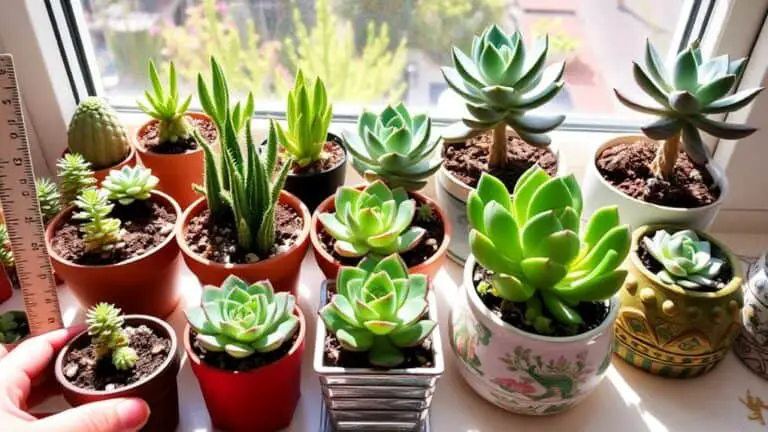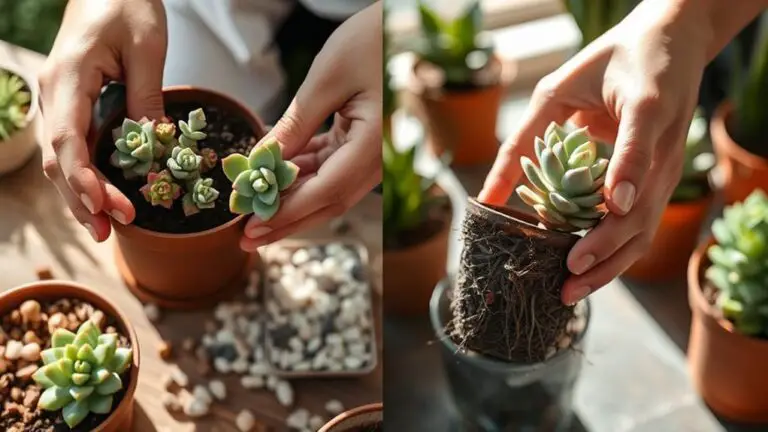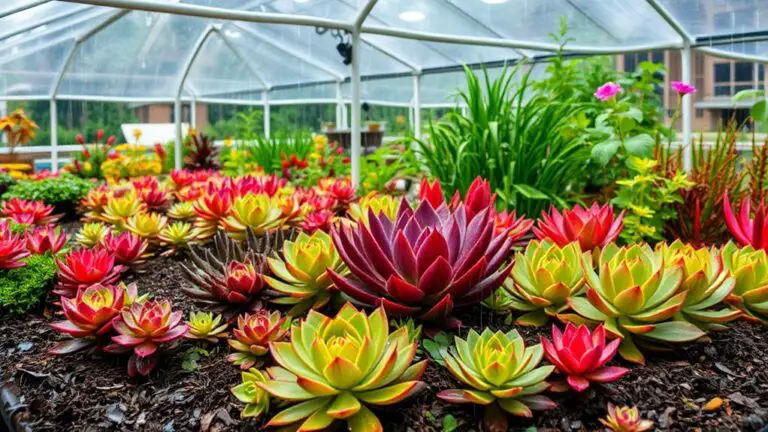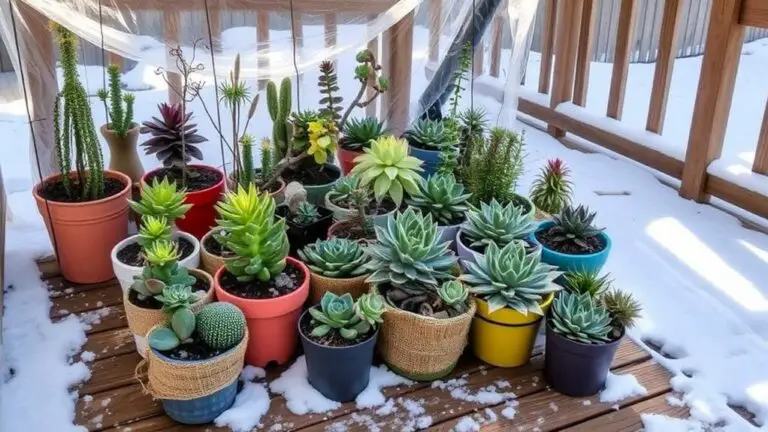Cactus Care Guide – 10 Essential Steps for Beginners
Starting your journey with cacti can be both rewarding and challenging. You'll need to master a few key techniques to guarantee your plants thrive, beginning with understanding the intricacies of watering practices and light requirements. It's not just about giving them a drink whenever you remember—there's a science to it. Proper soil mixes and potting methods are also vital, as they provide the foundation for growth. Are you curious about how to avoid common pitfalls like overwatering and pest infestations? Let's explore these essential steps and more to help your cacti flourish.
Watering Practices
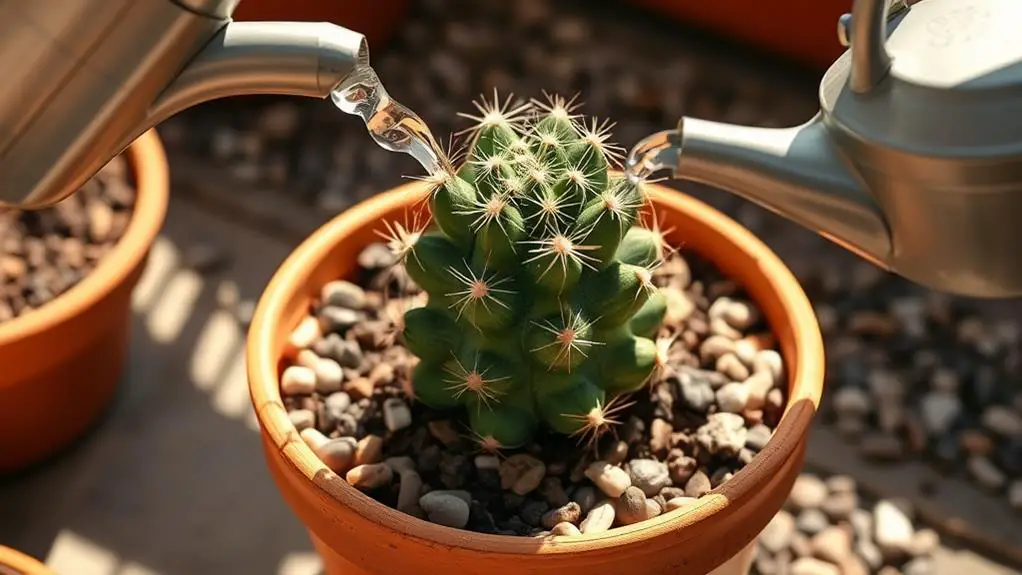
When caring for cacti, proper watering practices are essential to prevent root rot and guarantee healthy growth. First, always check if the top 2-3 inches of soil are completely dry before you water. This simple step helps avoid overwatering, which can lead to root rot.
Root rot shows up as a soft texture, brown spots, and yellowing. If you notice these signs, cut back on watering immediately.
During the growing season, which is Spring and Summer, aim to water your cactus every 2-3 weeks. As Autumn and Winter roll around, reduce this to once every three to four weeks. Overwatering in colder months can be particularly harmful.
On the flip side, be mindful of underwatering. Signs like shriveling and browning indicate your cactus might need more frequent watering.
Don't worry if you forget to water for a bit. Cacti are resilient and can handle extended periods without water. In the hot summer, they might need watering every 10-14 days, but they can often go much longer.
Light Requirements

Ever wondered what makes cacti thrive and bloom? It all comes down to understanding their light requirements. Cacti thrive in bright sunlight, needing 4 to 6 hours of exposure daily, but ideally, they should get 6 to 8 hours.
For indoor cacti, place them in bright rooms or near a south or west-facing window. This positioning guarantees they receive the necessary light. If your cactus starts bending toward the light, it's a sign you might need to move it to a brighter location.
However, not all cacti crave intense sunlight. Forest cacti, like Christmas cacti, prefer filtered sunlight. Shield them from harsh direct sunlight to avoid damage and stress.
Watch for signs of too much direct sunlight, such as yellow or brown discoloration on the cactus. These spots indicate sunburn and mean it's time to adjust their light exposure.
Insufficient light is another issue to watch for. If your cactus looks stretched or bleached, it's experiencing etiolation. This means it needs more light. Move it to a brighter spot to help it regain its vibrant appearance.
Soil and Potting
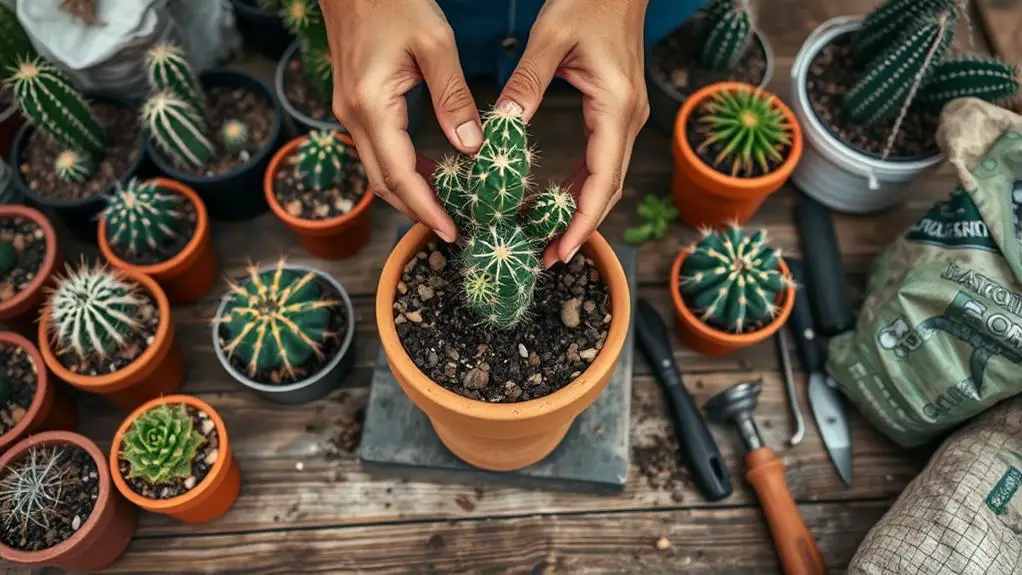
Proper soil and potting are vital for guaranteeing your cactus remains healthy and vibrant. To start, always use cactus soil. This cactus-specific mix includes sand, grit, and perlite, which guarantees well-draining soil and helps prevent root rot. Regular potting soil holds too much moisture and can lead to bacterial growth and suffocated roots.
Terracotta pots are fantastic for cacti because they allow moisture to evaporate and provide better air circulation to the roots. Make certain your pots have drainage holes to let excess water escape, which is vital for keeping your cactus happy. Repot your cactus every 2-3 years to refresh soil nutrients and accommodate growth. This process also helps maintain a soil pH that should be slightly acidic to neutral, around 6.0-7.0.
When repotting, handle your cactus carefully. Use gloves or tools to avoid getting pricked by spines and minimize stress on the plant. Remember, a well-draining soil mix and the right pot will set your cactus up for success.
Here's a quick reference table for you:
| Aspect | Recommendation |
|---|---|
| Soil Type | Cactus-specific mix |
| Ideal Pot | Terracotta pots |
| Repotting Frequency | Every 2-3 years |
Feeding and Nutrients
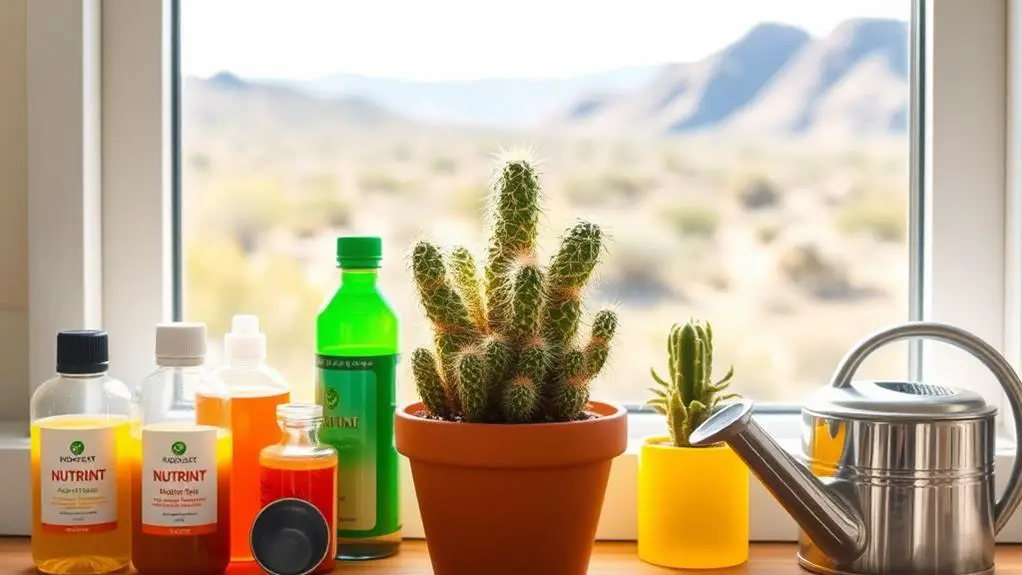
Once you've got the right soil and pot, the next step to guaranteeing your cactus thrives is feeding it properly. Cacti aren't heavy feeders, but they do need the right nutrients to grow strong and healthy.
During the active growing season (Spring and Summer), use a low-nitrogen cactus blend fertilizer. This type of fertilization promotes healthy growth and can even encourage flowering.
Fertilize your cactus once in Spring and again in Summer. Always make certain to apply the fertilizer to damp soil. Water your cactus first, then add the fertilizer. This helps prevent root burn and guarantees the nutrients are absorbed effectively.
Avoid feeding your cactus during dormant periods in Autumn and Winter. Feeding during these times can stress the plant, as it's not actively growing.
Keep an eye on your cactus for signs of nutrient deficiency, like stunted growth or discoloration. If you notice these signs, adjust your feeding schedule accordingly.
A well-fed cactus is more likely to thrive and stay healthy. By following these steps, you'll help your cactus get the nutrients it needs without overdoing it. Happy growing!
Pest Management

Guarding your cactus against pests is essential for its health and longevity. Regularly inspecting your cacti for common pests like mealybugs, spider mites, and Cochineal scale bugs is vital. These pests can cause significant damage if left untreated, leading to discoloration or even death.
Maintaining dry, sunny conditions with good airflow around your cacti helps deter pest infestations, as many pests thrive in humid environments.
Here are some practical steps to keep your cacti pest-free:
- Inspect regularly: Look for common pests and signs of stress, such as discoloration or wilting.
- Use neem oil: Treat minor infestations with neem oil, ensuring you cover all surfaces of the cactus.
- Quarantine new plants: Keep new plants isolated for at least two weeks before adding them to your collection.
- Clean the area: Remove debris around your cacti to eliminate hiding spots for pests.
Choosing the Right Cactus
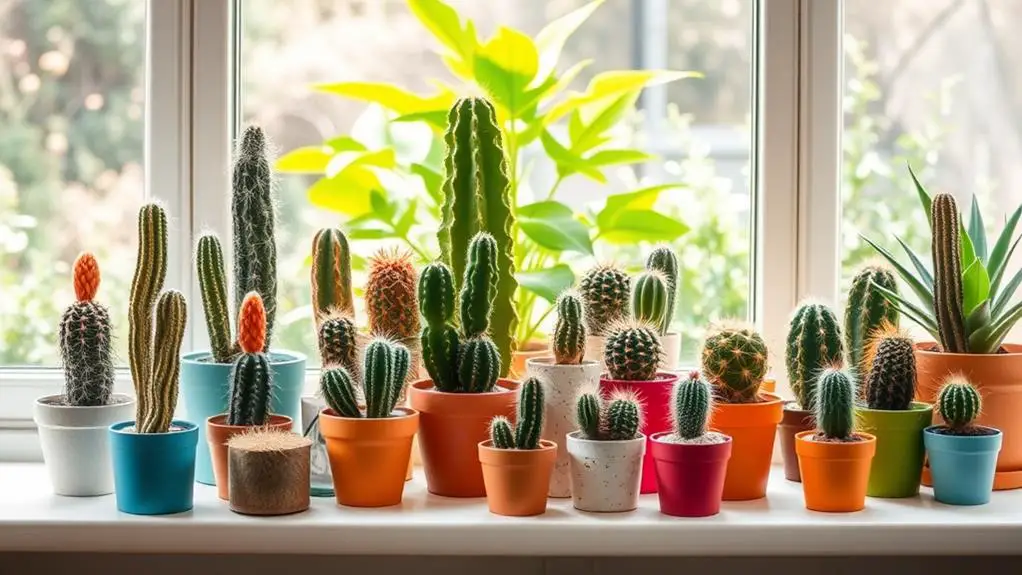
When choosing the right cactus, start with beginner-friendly options like the prickly pear, which is easy to care for and adaptable.
Remember, cacti come in all sizes, from small Mammillaria to the towering Saguaro, so consider the space you have available.
Pay attention to their light needs; desert cacti love direct sunlight, while forest cacti thrive with filtered light, making placement essential for healthy growth.
Beginner-Friendly Cactus Varieties
Choosing the right cactus can make all the difference for beginners enthusiastic to start their succulent journey. Some cactus plants are more beginner-friendly than others, making it easier for you to dive right into your new hobby. Here are a few varieties to contemplate:
- Prickly Pear Cactus: Known as Opuntia, this resilient cactus thrives in various conditions and even produces edible fruit. It's a great choice for beginners due to its hardiness.
- Golden Barrel Cactus: The Echinocactus grusonii stands out with its striking appearance, growing up to 4 feet tall. It's low-maintenance, making it perfect for those new to cactus care.
- Star Cactus: Also called Astrophytum asterias, this compact variety features unique star-shaped bodies and vibrant flowers. Its small size makes it ideal for limited spaces.
- Pincushion Cactus: The Mammillaria species is small, easy to care for, and produces colorful blooms. It can tolerate a range of light conditions, making it perfect for beginners.
Additionally, you might want to contemplate the Hedgehog Cactus (Echinocereus). It offers beautiful flowers and a manageable size, making it another excellent option for novice gardeners.
Light and Space Needs
Understanding the light and space needs of your cactus is vital for its health and growth. Most cacti thrive in bright, direct sunlight, needing 4-6 hours of daily exposure to grow well and bloom. Ideally, they should get a total of 6-8 hours of sunlight. If you're keeping your cactus indoors, place it in a south or west-facing window to guarantee it gets enough light. If you notice your cactus bending towards the light source, it needs more sun.
Forest cacti, like Christmas cacti, have different needs. They prefer filtered sunlight and should be protected from intense direct sunlight to avoid leaf burn.
It's important to gradually introduce young cacti to direct sunlight. Sudden exposure can cause sunburn, which appears as yellow or brown discoloration on the plant.
Pay attention to signs of sunburn or stretching (etiolation). Both indicate your cactus isn't getting the right amount of light. If you spot these signs, adjust its position to guarantee it gets the proper light it needs.
Care Requirements Overview
After confirming your cactus gets the right amount of light and space, it's time to focus on selecting the right type for your environment.
When choosing cacti and succulents, you'll need to take into account their care requirements, especially if you're a beginner. Some cacti, like the Saguaro, can grow up to 60 feet tall, so it's important to know the size and growth habits of your chosen plant.
For those new to cactus care, beginner-friendly options such as the prickly pear and golden barrel cactus are excellent choices due to their hardiness and low maintenance needs.
Lighting conditions are significant. Desert cacti thrive in bright, direct sunlight, while forest cacti prefer filtered light. Make sure to match the cactus type to your indoor lighting conditions to guarantee healthy growth.
Also, research the specific USDA hardiness zones for each species, like the golden barrel, which thrives in zones 9-11.
Reflect on these tips when choosing your cactus:
- Size and Growth Habits: Understand how big your cactus will grow.
- Lighting Needs: Match the cactus type to your available light.
- Hardiness Zones: Confirm the species can thrive in your outdoor environment.
- Visual Appeal: Look for unique features like vibrant blooms or striking appearances.
Repotting Guidelines
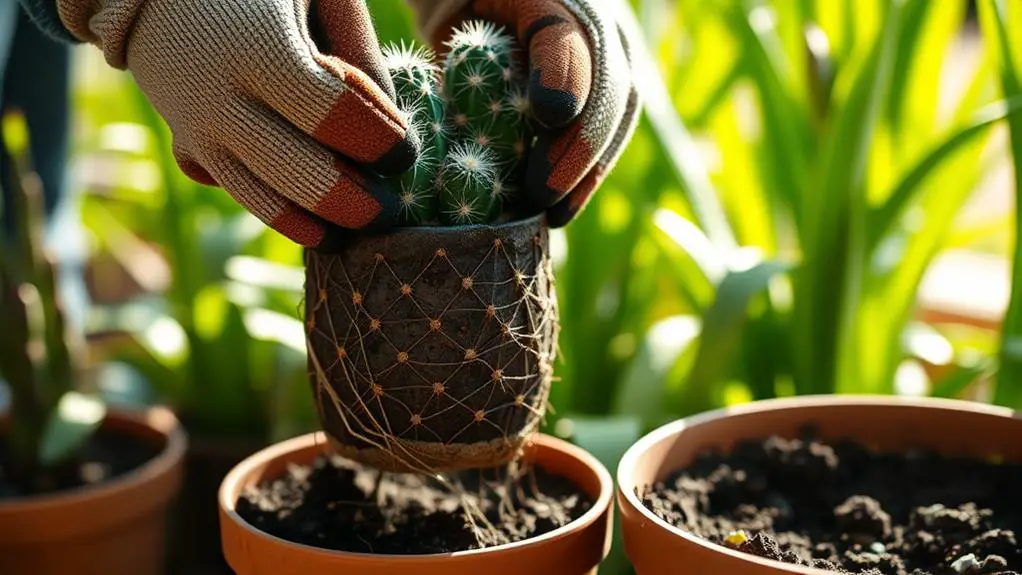
When it's time to repot your cactus, make sure you're choosing a pot with good drainage, like a terracotta one, to prevent water buildup.
Refresh the soil with a cactus-specific mix that drains quickly.
Handle your cactus carefully to avoid damaging its roots or getting pricked by its spines.
Choosing Appropriate Pot
Choosing the right pot for your cactus isn't just about aesthetics; it's important for the plant's health and growth. First, make certain the pot you select is only slightly larger than the current one. Cacti love snug environments, which helps them grow more robustly.
Opt for terracotta or clay pots since they allow better air circulation to the roots and help moisture evaporate faster. This is essential because cacti need well-draining conditions to thrive.
Drainage holes are non-negotiable. Without them, water can accumulate, leading to root rot, which is a common killer of cacti. When you repot your cactus, do it every 2-3 years to refresh the soil nutrients and encourage growth.
Handle your plant with gloves or tools to avoid injury from the spines. When it's time to repot, use a well-draining potting mix. A good mix includes equal parts soil, sand, peat moss, and perlite. This guarantees the right balance of drainage and aeration, which is crucial for the health of various cactus species.
Here's a quick checklist for choosing the right pot:
- Make certain it's only slightly larger than the current pot
- Opt for terracotta or clay pots
- Make sure it has drainage holes
- Use a well-draining potting mix
Refreshing Soil Mix
Once you've selected the right pot, the next step is revitalizing the soil mix to guarantee your cactus thrives.
Begin by gently removing your cactus from its old pot, taking care not to damage the roots. Shake off any old soil clinging to the roots. This helps remove any depleted soil and gives you a fresh start.
When you repot, choose a pot that's just slightly larger than the current one. This prevents excess moisture retention, which can lead to root rot.
The new soil mix should be well-draining and specifically tailored for cacti. A cactus-specific soil mix usually contains sand and grit to enhance drainage, allowing water to pass through quickly, ideally within a minute of watering.
Place a layer of this well-draining soil at the bottom of the new pot. Position your cactus in the center and fill around it with more soil, making sure the roots are covered but not packed too tightly.
After repotting, it's essential to wait at least a week before watering. This allows the roots to settle and reduces the risk of root rot.
Following these steps will guarantee your cactus has the right environment to grow strong and healthy.
Seasonal Care

Seasonal care is essential for maintaining a healthy cactus, guaranteeing it thrives year-round. Understanding how to adjust your care routine based on the season will keep your cactus happy and vibrant.
During Spring and Summer, cacti are in their growing season. You'll need to water them every 2-3 weeks, letting the soil dry out completely between sessions to prevent root rot.
Assure they get 6-8 hours of bright sunlight daily to avoid etiolation. Fertilize with a low-nitrogen or cactus-specific blend every few weeks to support healthy growth and flowering.
When Autumn and Winter arrive, cacti enter dormancy and need less water. Reduce watering to once a week or every 3-4 weeks.
Adjust their light exposure if needed to prevent sunburn. Repot your cactus every 2-3 years to refresh the soil and provide room for growth. Use well-draining soil to avoid water accumulation.
- Watering: Every 2-3 weeks in growing season; every 3-4 weeks during dormancy.
- Sunlight: 6-8 hours daily, adjusting to prevent sunburn.
- Fertilizing: Low-nitrogen or cactus-specific blend during active growth.
- Repotting: Every 2-3 years with well-draining soil.
Handling Tips
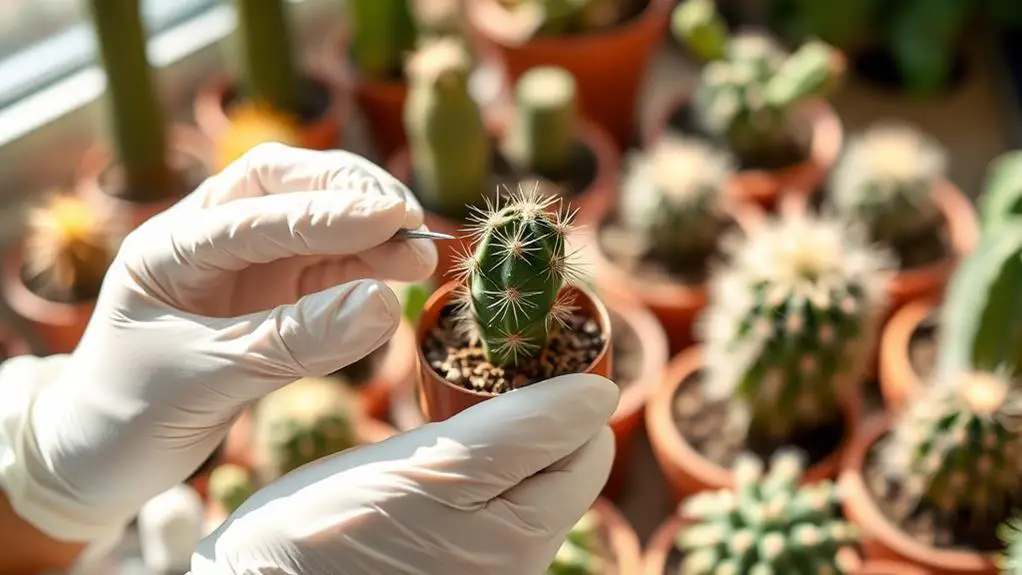
Handling cacti requires careful attention and the right tools to secure both your safety and the plant's well-being. Always wear gloves to protect your hands from sharp spines and needles. Many cactus species can cause skin irritation or injury if not handled properly.
For safe handling, use kitchen tongs or tweezers to reposition or transplant your cacti. This minimizes contact with the spines and guarantees you're less likely to get pricked.
When it comes to safe transportation, wrap your cacti in newspaper or towels. This simple trick prevents accidental punctures to your skin and protects the plant from damage.
When it's time for repotting, be gentle. Loosen the root ball carefully and remove old soil without disturbing the roots too much. This promotes healthy growth and helps the cactus adjust to its new pot.
Don't forget to keep a first aid kit nearby. Accidents can happen, even with careful handling. Stock it with antiseptic wipes and band-aids for minor injuries from spines.
Following these handling tips makes cactus care safer and more enjoyable, ensuring both you and your cactus thrive.
Common Issues
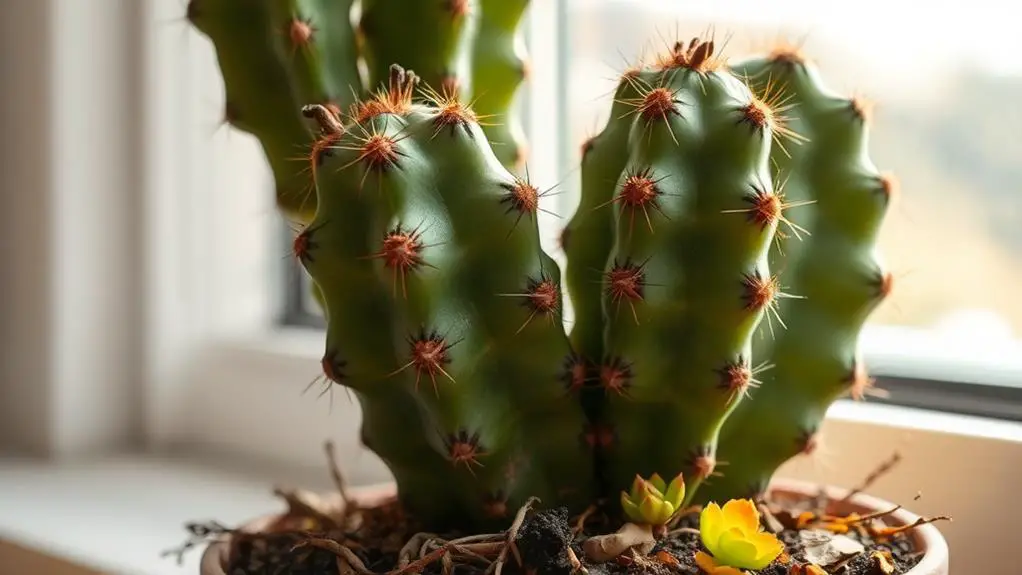
When caring for cacti, it's crucial to recognize and address common issues to keep your plants healthy.
Overwatering is a frequent problem, leading to root rot. You'll notice soft, mushy stems and brown spots. If this happens, stop watering immediately and let the soil dry out completely.
Pests like mealybugs and spider mites can infest your cacti, causing discoloration and wilting. Regularly inspect your plants and treat infestations with insecticidal soap.
Insufficient light can cause etiolation, where your cactus stretches towards the light source, becoming weak and off-color. Confirm your cactus gets 6-8 hours of bright light daily to prevent this.
Sudden exposure to intense sunlight can result in sunburn, indicated by yellow or brown discoloration. Gradually acclimatize your cactus to brighter conditions to avoid this issue.
Corking, which appears as rough, brown patches at the base of the cactus, is a natural aging process and isn't harmful. However, if it bothers you, consider propagating from healthy cuttings.
Here's a quick checklist to help you identify and manage these common issues:
- Overwatering: Look for root rot signs and let the soil dry out.
- Pests: Check for mealybugs and spider mites, and treat with insecticidal soap.
- Sunlight: Confirm 6-8 hours of bright light to avoid etiolation.
- Acclimatization: Gradually introduce your cactus to brighter light to prevent sunburn.
Follow these steps, and you'll be on your way to maintaining healthy, thriving cacti!
Frequently Asked Questions
How to Take Care of a Cactus for Beginners?
Water your cactus every few weeks, ensuring the soil is dry first. Place it in bright sunlight for 6-8 hours daily. Use well-draining soil, repot every few years, and fertilize during the growing season.
Does Coffee Help Cactus?
Yes, coffee grounds can help your cactus by providing nitrogen and slightly acidic conditions. However, use them sparingly and mix into the soil. Avoid using brewed coffee directly, and apply only once a month during growth seasons.
How to Keep Cactus Alive Indoors?
To keep your cactus alive indoors, place it in a south or west-facing window for ample sunlight. Water every 2-3 weeks, use well-draining soil, and check for pests. Don't forget to fertilize during the growing season.
How Can I Make My Cactus Happy?
To make your cactus happy, give it 6-8 hours of direct sunlight daily and water every 2-3 weeks, letting the soil dry between waterings. Use well-draining soil and fertilize with a low-nitrogen blend during growth.
Conclusion
You've got everything you need to start your cactus care journey! By following these steps, you'll provide your cactus with the right water, light, and nutrients, ensuring it thrives. Don't forget to check for pests and repot when needed. Handling your cactus safely and addressing common issues promptly will keep it healthy. Keep learning and experimenting, and soon, you'll be a confident cactus caretaker. Happy gardening, and enjoy watching your cactus flourish!

